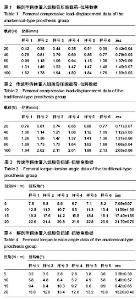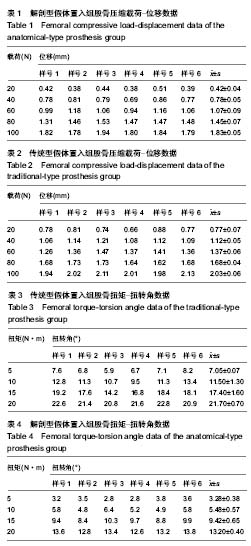| [1] 卢世璧,译.凯贝尔骨科手术学[M]. 9版.济南:山东科学技术出版社,2004:294-295.
[2] Mellal A, Wiskott HW, Botsis J, et al. Stimulating effect of implant loading on surrounding bone. Comparison of three numerical models and validation by in vivo data. Clin Oral Implants Res. 2004;15:239-248.
[3] Kutzner I, Heinlein B, Graichen F. Loading of the knee joint during activities of daily living measured in vivo in five subjects. J Biomech. 2010;43:2164-2173 .
[4] Yao J, Wen C, Cheung J. Deterioration of stress distribution due to tunnel creation in single-bundle and doublebundle anterior cruciate ligament reconstructions. Ann Biomed Eng. 2012; 40:1554-1567.
[5] Levine JW, Kiapour AM, Quatman CE. Clinically relevant injury patterns after an anterior cruciate ligament injury provide insight into injury mechanisms. Am J Sports Med. 2013;41: 385-395.
[6] Rudman KE,Aspden RM,Meakin JR.Compression or tension?The stress distribution in the proximal femur. Biomed Eng Online.2006;5(5):12.
[7] Wang XS,Jiang FC,Ma J,et al.Human hip stress evaluations in vivo at dynamic cases. J Med Biomech. 2005;20(2):91-96.
[8] Sangiorgio SN,Ebramzadeh E,Longjohn DB,et al.Effects of dorsal flanges on fixation of cemented total hip replacement femoral stem. J Bone Joint Surg Am. 2004;86(4):813-820.
[9] Mandell JA,Carter DR,Goodman SB,et al.A conicalcollared intramedullary stem can improve stress transfer and limit micromotion. Clin Biomech(Bristol,Avon). 2004;19(7): 695-703.
[10] Whiteside JA,Junichi A,Stephen E,et al.Fixation of the modular total hip femoral componet in cementless total hip arthoplasty.Clin Orthop. 1994;298:184-190.
[11] 李明,何志勇,陶崑.全髋表面置换术后与正常股骨近端生物力学比较[J].医用生物力学,2014,29(3):213-218.
[12] 郝思春,蒋建农,陈俊,等.股骨偏心距对全髋关节置换术中应力水平影响的三维有限元分析[J].中华关节外科杂志(电子版), 2013, 7(5):700-704.
[13] Beulah P, Sivarasu S, Mathew L. Design optimization of skeletal hipimplant cross-sections using finite-element analysis. J Long Term Eff Med Implants. 2009;19(4):271-278.
[14] Fouad H. In vitro evaluation of stiffness graded artificial hip joint femur head in terms of joint stresses distributions and dimensions: finite element study. J Mater Sci Mater Med. 2011;22(6):1589-1598.
[15] 张福江,肖瑜.有限元分析在人工髋关节中应用的研究进展[J]. 天津医药,2011,99130871-873.
[16] 吕雅平,冯铁键,马洪顺. 氟中毒动物模型蠕变实验研究[J].中国地方病防治杂志,2010,25940:95.
[17] 王溪原,张远石,苑福生,等.正常与病态股骨头应力松弛特性的对比分析[J].生物医学工程研究,2011,30(1):49-52.
[18] 罗民,李新颖,马洪顺. 股骨下端松质骨横向与纵向的蠕变特性[J].生物医学工程研究,2012,31(1):24-27.
[19] 钟显春,罗民,李新颖.几种药物治疗骨质疏松模型大鼠股骨蠕变特性的对比分析[J].生物医学工程研究,2012,31(3):180-183.
[20] 彭传刚,杨琦,李鹏. C3-4、T9-10、L2-3椎间盘与相邻椎体弯曲(屈曲)的力学特性[J].生物医学工程研究,2013,32(2):94-96.
[21] Kim YH,Kim JS,Cho SH.Strain distribution in the prximal human femur.An in vitro comparison in the intact femur and after insertion of reference and experimental femoral stems. J Bone Joint Surg(Br). 2001;83(2):295-301.
[22] 李永丰,杜伟明,王以进.人工髋关节设计中颈长颈干角对应力分布的影响[J].上海大学学报:自然科学版,1997,3(1):44-48.
[23] 左建林,杨勇,高忠礼.全髋关节置换的生物力学及相关问题[J].吉林大学学报:医学版,2005,31(3):483-486.
[24] 唐国瑜,匡光志.髋臼假体的方位对假体骨水泥界面应力分布的影响[J].海南医学,2003,14(11):86-88.
[25] Mukherjee DP, Saha S. The application of new composite materials for total joint arthoplasty. J Long Term Eff Med Implants. 1993;3(2):131-141. |

